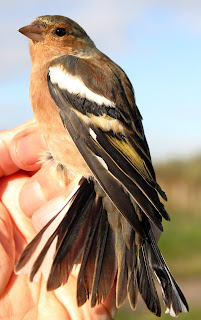I looked in my notebook to see that I had been so busy ringing out on the moss that I hadn’t been to Lane Ends my other home, since September 20th. It was a good decision last night to postpone more ringing, with an accurate BBC forecast that predicted after a 9mph start, that the wind would increase quickly. But I must say I was ready for a leisurely birding session after the hard slog of ringing and Sunday looks more promising for mist nets.
I was pretty much the first person at Fluke Hall, early enough to find a Snipe on the wet, roadside stubble together with 8 Meadow Pipits and 2 wagtails that flew ahead of me before I could ID them properly – more “albas” in the notebook. There didn’t seem a lot of overhead stuff, just several Chaffinch and a couple of Greenfinch, but as I walked up towards Ridge Farm I did get 5 Reed Bunting, 3 over fairly high and 3 along the hedgerow. Below the sea wall were the obligatory 2 Little Egret and a Wheatear on the boulder stones. There were masses of Pink-footed Geese out on the marsh already flighting off to the sound of gunfire, and I made a mental note to count the flocks when I got up to Lane Ends.
 Pink-footed Goose
Pink-footed GooseI stopped at a partially flooded field at Damside, a favoured spot where autumn Ruff sometimes join the Redshanks and Lapwings. I looked through a flock of 40 Lapwings, and yes amongst them was indeed a single Ruff, but tantalisingly too far for a picture.
At Lane Ends a tit flock moved through the wood where with the usual long and short tailed variety I found a Treecreeper doing just as the label says, creeping up the side of a silver birch before it flew off with the rest of the horde. Obviously Treecreepers are fairly unusual at this spot but I ringed one here in 1997 and an earlier one was ringed by my colleague Simon in 1989; Simon is now “down south” where he rings Dartford Warblers, Firecrests and the occasional Hobby. And no, I don’t have a fantastic memory but IPMR the BTO ringer’s database does. There were a few obvious migrant Blackbirds here, dashing, secretive and in a hurry to feed up.
 Treecreeper
TreecreeperThere were more Little Egrets out on the marsh and my combined count from here, Fluke Hall and Pilling Water came to a round ten. That doesn’t approach the counts of 30 or so birds that have roosted on the island in recent weeks, but when they leave the roost they scatter west towards Knott End and east in the direction of Cockerham, a stretch of coast where a concerted daytime count effort would surely yield thirty or more individuals.
 Little Egret
Little Egret Towards Pilling Water was quiet, another single Wheatear,a couple of Meadow Pipits plus 30 or so Skylarks coming off the marsh and flying gently inland, but as always with Skylarks the mystery is not only “Why?”, but also “Where and When?” My casual estimate of Pink-footed geese was 12-15,000, huge but almost uncountable numbers.
 Skylark
SkylarkOn my way to Conder Green I detoured via Jeremy Lane where I encountered a group of 10 Grey Partridge. Now if they are truly wild that is something to write home about, but I hope they are not released birds as I hear that some shooting syndicates may have released some recently with the hope of taking them back dead later. It’s just nonsensical to shoot all the Grey Partridge, complain there aren’t any, breed birds in captivity and then release them to shoot all over again; seemingly they are better “sport” than Red-legged Partridge.
At Conder Green I heard birders complaining about the lack of birds. Alright it wasn’t busy but it helps if you spend a little time and look properly instead of dashing off, foot on the floor, to the next place on the list. I found 9 Little Grebe, 3 Wigeon, 6 Snipe, 1 Grey Wagtail, 2 Cormorant, 160 Goldfinch, 45 Curlew, 1 Common Sandpiper, 2 Meadow Pipit and 1 Kingfisher. As the group fretted amongst themselves and earnestly discussed next options I watched 2 Barnacle Geese fly over, not too high but heading south west towards the pinkies.
Also today, here and there, several lingering Swallows.
























































.jpg)











